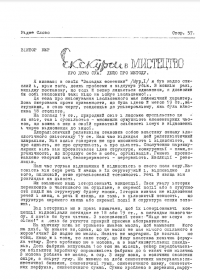Excursions into art: Pro domo sua. Something about the method. In Ridne slovo, No. 12, 1946, pp. 57-65.
Keywords:
philosophy of history, philosophy of art, philosophy of science, philosophy of Ukrainian emigrationSynopsis
The article presents the reflections of Viktor Ber (one of the pseudonyms of Viktor Petrov) on the research vision that was widespread in the first half of the twentieth century - the negation of the idea of the continuity of history in the humanities (in particular, in the philosophy of history - ‘historiography’). The article consists of four parts: 1) Pro domo sua. Something about the method; 2) Mosaics of Ravenna and Ribeira; 3) Modern Art and Modern Physics; 4) The Futurist Manifesto of 1909, re-read today.
In the first part, he refers to Hegel's dialectical method to show his understanding of historiography: ‘In the gradation of epochs, each subsequent epoch can be said to construct itself through negation, to oppose itself to the previous one, and to be the negative form of this previous one. At the same time a negation and an affirmation’ (p. 59).
In the second part, the author compares two works of art - a fragment of the sixth-century mosaic ‘Adoration of the Magi’ in the Church of St. Apollinari (Basilica di Sant'Apollinare Nuovo) in Ravenna and the eponymous painting by the Spanish artist Jusepe de Ribera of 1650. This comparison is due to the author's desire to show how the ideology and worldview inherent in each of the eras are reflected in art. Based on the results of the analysis of the artistic features of each work, he argues that the art of the early Middle Ages is characterised by a metaphysical-theistic worldview, and the art of the modern period - by a humanistic-naturalistic one.
In the third part, the author emphasises that contemporary art and physics, independently of each other, ‘have shown a tendency to develop in the same direction’ (p. 63), as has contemporary philosophy, which rejects the concepts of time and space of classical physics.
In the fourth part, Ber proposes to rethink the odious pre-war manifesto of the Futurists, published in 1909 in the journal Figaro, from the perspective of the First and Second World Wars.
Vlada Davidenko
Downloads




